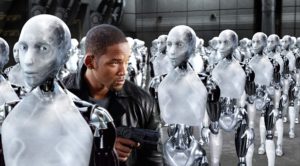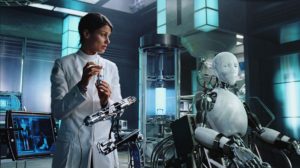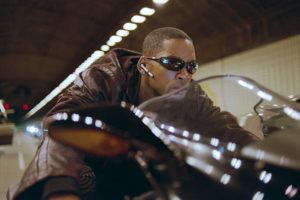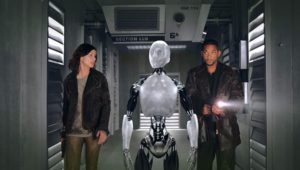Recommended movie: “I Robot”
The rave of the stoned robot
 Any fan of the sci-fi author Isaac Asimov’s books, watching “I, Robot”, will surely have been a bit disappointed, as the film did not follow any of the writer’s books and tales. However, it is as if the screenwriter had opened the pages of that book at random, and it is possible to recognize various ideas, drawn from different tales, in a déjà vu that serves to enrich what would be just another action movie.
Any fan of the sci-fi author Isaac Asimov’s books, watching “I, Robot”, will surely have been a bit disappointed, as the film did not follow any of the writer’s books and tales. However, it is as if the screenwriter had opened the pages of that book at random, and it is possible to recognize various ideas, drawn from different tales, in a déjà vu that serves to enrich what would be just another action movie.
In the year 2035, robots are usual home appliances, monopolized by a single corporation, US Robots (did Asimov in 1950 already envision the monopoly that Microsoft and Amazon would have?). Although most of the population gladly accept robots, especially for manual labor, police officer Spooner (Will Smith) remains averse to these mechanized beings.
The biggest virtue of robots, besides the obvious slave labor, is the presence of three directives, implanted directly in their positronic brains (don’t ask what is this, Asimov himself had no idea …), called Robotics Laws:
1st Law: A robot cannot injure a human being or, by default, allow a human being to suffer any harm.
2nd Law: A robot must obey the orders given to it by humans, except in cases that in such orders contradict the First Law.
3rd Law: A robot must protect its own existence, provided such protection does not contradict the First and Second Laws.
 Due to a traumatic experience in the past, Spooner rejects this trust in robots, making a point of showing his prejudice towards them. One day, one of the top US Robots scientists commits suicide, leaving a mysterious message for the detective.
Due to a traumatic experience in the past, Spooner rejects this trust in robots, making a point of showing his prejudice towards them. One day, one of the top US Robots scientists commits suicide, leaving a mysterious message for the detective.
Intrigued, Spooner begins to investigate the case, aided by a robot psychologist, Susan Calvin (Bridget Monayhan), who is surprised to find that all evidence points to Sonny, a robot in the brand new Nestor series, about to be launched on market.
The new robots are part of an ambitious US Robots distribution project that will provide one automaton for every five humans. Meanwhile, strange facts happens, always involving robots. Spooner barely escapes from demolition and turning into truck sandwich.
 Disbelieved by all, Spooner races against time and events to prove that he is not mad, and that his suspicions of conspiracy are true. Stop. To learn more, watch the movie.
Disbelieved by all, Spooner races against time and events to prove that he is not mad, and that his suspicions of conspiracy are true. Stop. To learn more, watch the movie.
Those who lived with Asimov’s books, “I, Robot” in particular, will find many familiar points. Psychologist Susan Calvin, central character in most stories, has been relegated to the background in the film. Her caustic and bitter personality, since she only lov4ed robots, was quite softened, as well as earning a pretty face. Other characters, such as Dr. Lanning and bureaucrat Robertson, are also present in Asimov’s various books on robots.
 The tale that seems to have served as the main inspiration is “The Lost Little Robot”. In the story, a Nestor series space station robot had fled and needed to be identified among 62 identical replicas. This scene was magnified magnificently in the movie with a thousand robots created in computer graphics.
The tale that seems to have served as the main inspiration is “The Lost Little Robot”. In the story, a Nestor series space station robot had fled and needed to be identified among 62 identical replicas. This scene was magnified magnificently in the movie with a thousand robots created in computer graphics.
Another idea of Asimov, present in the movie, is that of the “Frankenstein Complex”. As in Mary Shelley’s book, it means the fear of the monster that turns against its creator. Also noticeable is a certain resemblance to series “The Matrix”, whose revolution of the Machines began after a robot murdered its bosses.
 The cast is doing very well, especially Will Smith, who found that acting well is not just making funny faces. Also, in many scenes he must have acted in the void, as the robots were filled with computer graphics in the editing phase of the film.
The cast is doing very well, especially Will Smith, who found that acting well is not just making funny faces. Also, in many scenes he must have acted in the void, as the robots were filled with computer graphics in the editing phase of the film.
The unpleasant point of the movie is the blatant merchandising, with scenes like “how about this model of tennis 2004?”, as well as exhibitions of car brand, sound, delivery company, etc ..
A curious aspect, intentional or not, is the strong resemblance of the film’s robots to foreigners in the United States. Despite the general contempt, and strong prejudice, they are necessary for dirty or manual labor, which the “purebred” American does not like to do.
 Cinematographically speaking, “I, Robot” leaves nothing to be desired in relation to any other current or past production of its kind. The elaborate special effects complement the story rather than take the place of the actors. The film earned a 2005 Oscar nomination for Best Visual Effects.
Cinematographically speaking, “I, Robot” leaves nothing to be desired in relation to any other current or past production of its kind. The elaborate special effects complement the story rather than take the place of the actors. The film earned a 2005 Oscar nomination for Best Visual Effects.
“I, Robot ” was directed by Alex Proyas, who would direct later “Gods of Egypt” (“Gods of Egypt, USA, 2016). Marco Beltrami’s soundtrack is fantastic, and the sound effects very well done. I remember watching this movie in a cinema in Rio de Janeiro, and I was amazed by the sound already in the opening credits.
This is a movie that has not aged, although it is already from the new millennium. Considering the current wave of empty movies where the special effects take the lead roles, “I, Robot” maintains the right balance, being a great entertainment for action movie lovers, even those who are not fans of science fiction.
ROBOTS IN CINEMA AND LITERATURE
 The word “robot” is of Czech origin, meaning servant or slave. It was adapted by the Czech writer Karel Capek (1890-1938) in his play “RUR” (Rosumovi Univerzální Roboti), 1921. In fact, the concept of automated machines dates back to antiquity, with myths of living mechanical beings such the ones Ulysses faced in his Odyssey. Automata, or people-like machines, were already present in medieval church clocks, as well as gadgets made by watchmakers, to the delight of their wealthy customers.
The word “robot” is of Czech origin, meaning servant or slave. It was adapted by the Czech writer Karel Capek (1890-1938) in his play “RUR” (Rosumovi Univerzální Roboti), 1921. In fact, the concept of automated machines dates back to antiquity, with myths of living mechanical beings such the ones Ulysses faced in his Odyssey. Automata, or people-like machines, were already present in medieval church clocks, as well as gadgets made by watchmakers, to the delight of their wealthy customers.
The writer who most surely published books and short stories about robots was Isaac Asimov, who began his stories in the 1950s with “I, Robot”, followed by dozens of other books, novels and short stories. Other authors also experimented with the theme, always present in science fiction stories.
In the movies, in addition to the “good” robots, such as R2D2 and C3PO, from “Star Wars”, came the “bad guys” from the “Terminator” series. Other famous apparitions are the “Metropolis” robot, HAL 9000 from “2001, A Space Odyssey”, “The Bicentennial Man”, and even the androids of Blade Runner and Alien.






